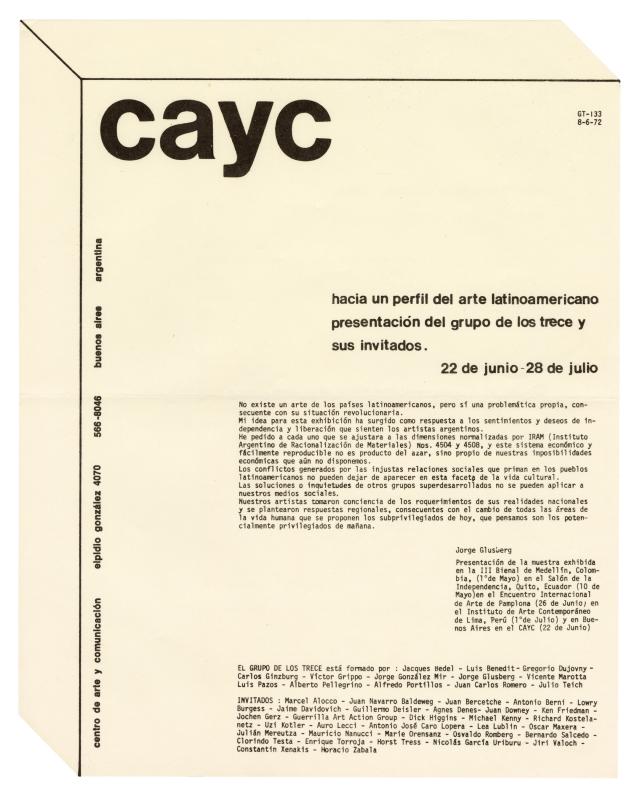Ever since it was founded, the CAYC (Centro de Arte y Comunicación), helmed by the cultural promoter, artist, and businessman Jorge Glusberg, was intended as an interdisciplinary space where an experimental art movement could flourish. The establishment of collaborative networks connecting local and international artists and critics played a key role in this process. The exhibitions shone a light on these exchanges, in which overviews of trends or individual artists introduced the innovations of international contemporary art and made Argentine and Latin American artists better known on the global scene.
Hacia un perfil… showed works in which Argentinean and international artists pondered the political situation that was common to all their countries. The exhibition provided a perspective on art and the Grupo de los Trece’s ideology in a concise overview of contemporary regional art. Arte de sistemas not only referred to international process art; its political stance, absorbed over the course of its many productions and presentations, gave it an identity of its own and associated it with the region of Latin America. In his introduction to the exhibition, Glusberg said: “There is no Latin American art as such, but the region’s individual countries do share a common problem in terms of their revolutionary situation” [GT-133 (doc. no. 1476312)].
Though the event announced in this newsletter has a different title, the list of participating artists makes it clear that the exhibition shown at the Agora Studio in Maastricht, Holland, in October 1974 was a version of Hacia un perfil del arte latinoamericano, which was shown for the first time at the III Bienal de Arte Coltejer in Medellín, Colombia. It had been presented at the CAYC in June 1974.
This newsletter clarifies the CAYC’s change of course, which involved a new phase in the center’s relationships with critics, agents, institutions, and circuits in various parts of Europe and the Americas. The Studio Agora was founded in Maastricht, Holland, in 1972 by the artists Theo van der Aa (1945–2015) and Ger van Dijck (b. 1939). Until the mid-1980s, capitalizing on its geographical location (close to the border between Germany and Belgium), the studio organized exhibitions and published “artists’ books” that catered to an international network of artists working in the fields of performance art, video art, and mail art. (Steetskamp, J. Jan van Eyck Academie, 2007.) The goals of the studio’s programs and projects were closely aligned with the CAYC’s plans in terms of their experimental nature and their attempts to promote campaigns for the circulation and exchange of artists and materials.

